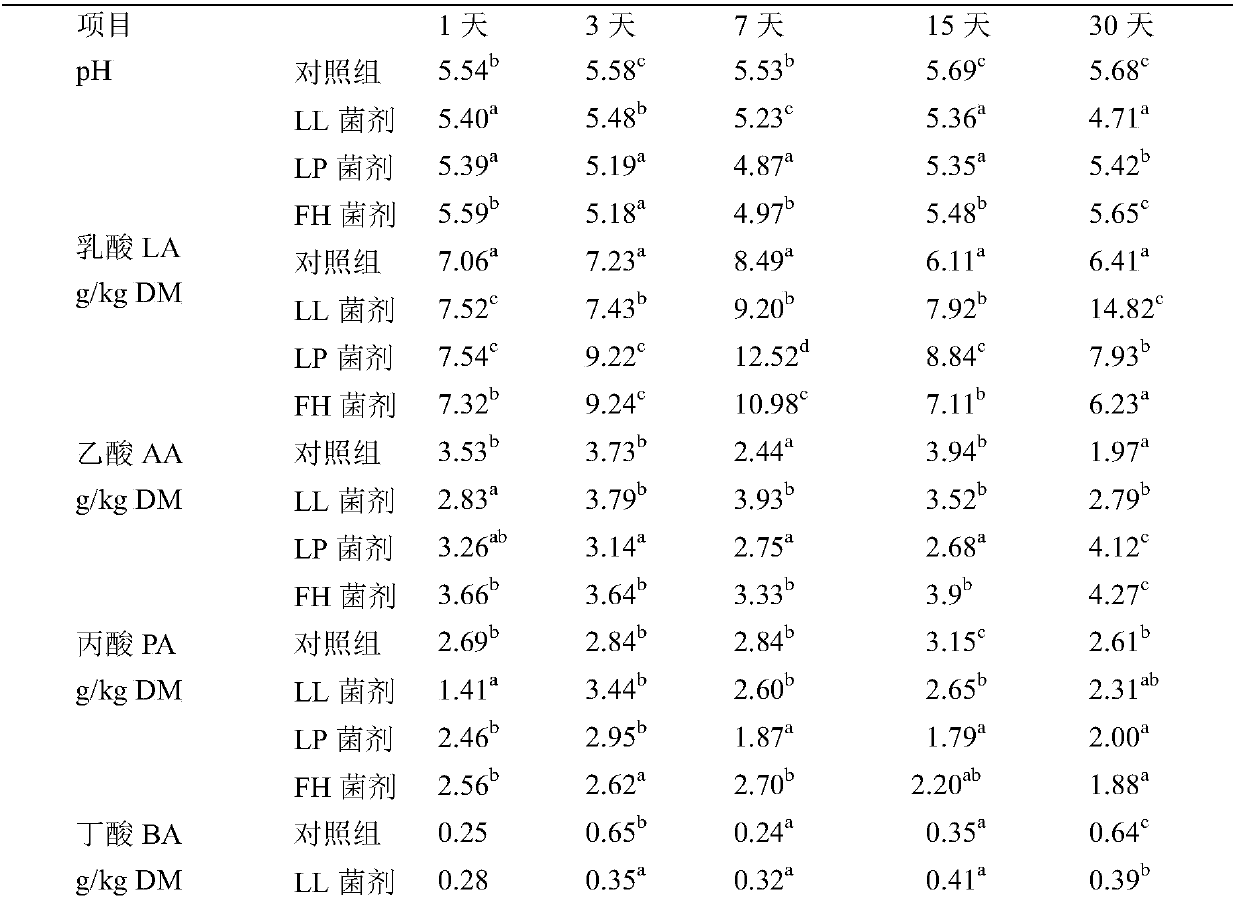Lactic acid bacteria microbial inoculant applicable to myriophyllum quaticum silage, and preparation method and application of lactic acid bacterium inoculant
The technology of green foxtail algae and green foxtail algae is applied in the field of lactic acid bacteria inoculum and its preparation, and can solve the problems of low silage protein content, low utilization rate of silage raw materials, non-degradation of cellulose, etc., so as to improve the protein content. , Inhibit the growth of fungi such as mold, and reduce the effect of cellulose content
- Summary
- Abstract
- Description
- Claims
- Application Information
AI Technical Summary
Problems solved by technology
Method used
Image
Examples
Embodiment 1
[0030] The preparation of embodiment 1 Lactococcus lactis inoculum
[0031] In the present embodiment, the preparation method of lactic acid bacteria inoculum comprises the following steps:
[0032] (1) Expanded culture of bacteria
[0033] Inoculate Lactococcus lactis in MRS liquid medium and culture at 37°C for 30 hours to obtain Lactococcus lactis liquid, then inoculate Lactococcus lactis liquid into new MRS liquid medium at a ratio of 1%, and inoculate at 37°C Expand the culture for 20 hours to obtain Lactococcus lactis culture fluid;
[0034] The composition of the MRS liquid medium is: 10.0g peptone, 10.0g beef extract, 5.0g yeast powder, 20.0g glucose, 5.0g sodium acetate, 1.0g Tween-80, 0.1g magnesium sulfate, 0.05g sulfate Manganese, 2.0g diammonium hydrogen citrate, 2.0g dipotassium hydrogen phosphate, 1000mL, sterilized for later use.
[0035] (2) Preparation of Lactococcus lactis bacterial agent
[0036] The obtained Lactococcus lactis culture solution was inoc...
Embodiment 2
[0038] The preparation of embodiment 2 Lactococcus lactis inoculum
[0039] In the present embodiment, the preparation method of lactic acid bacteria inoculum comprises the following steps:
[0040] (1) Expanded culture of bacteria
[0041] Inoculate Lactococcus lactis in MRS liquid medium and culture at 37°C for 26 hours to obtain Lactococcus lactis bacteria liquid, then inoculate Lactococcus lactis bacteria liquid into new MRS liquid medium at a ratio of 1.5%, at 37°C Expand the culture for 24 hours to obtain Lactococcus lactis culture fluid;
[0042] The composition of described MRS liquid medium is: 11.0g peptone, 11.0g beef extract, 6.0g yeast powder, 21.0g glucose, 6.0g sodium acetate, 1.5g Tween-80, 0.15g magnesium sulfate, 0.08g sulfuric acid Manganese, 3.0g diammonium hydrogen citrate, 3.0g dipotassium hydrogen phosphate, 1000mL, sterilized for later use.
[0043] (2) Preparation of Lactococcus lactis bacterial agent
[0044] The obtained Lactococcus lactis cultur...
Embodiment 3
[0046] The preparation of embodiment 3 Lactobacillus plantarum inoculum
[0047] In the present embodiment, the preparation method of Lactobacillus plantarum inoculum comprises the following steps:
[0048] (1) Expanded culture of bacteria
[0049] Inoculate Lactobacillus plantarum in MRS liquid medium and culture at 37°C for 30 hours to obtain Lactobacillus plantarum liquid, then inoculate the Lactobacillus plantarum liquid into new MRS liquid medium at a ratio of 1%, and incubate at 37°C Expand the culture for 20 hours to obtain the culture solution of Lactobacillus plantarum;
[0050] The composition of the MRS liquid medium is: 10.0g peptone, 10.0g beef extract, 5.0g yeast powder, 20.0g glucose, 5.0g sodium acetate, 1.0g Tween-80, 0.1g magnesium sulfate, 0.05g sulfate Manganese, 2.0g diammonium hydrogen citrate, 2.0g dipotassium hydrogen phosphate, 1000mL, sterilized for later use.
[0051] (2) Preparation of Lactobacillus plantarum inoculum
[0052] The obtained Lacto...
PUM
 Login to View More
Login to View More Abstract
Description
Claims
Application Information
 Login to View More
Login to View More - R&D
- Intellectual Property
- Life Sciences
- Materials
- Tech Scout
- Unparalleled Data Quality
- Higher Quality Content
- 60% Fewer Hallucinations
Browse by: Latest US Patents, China's latest patents, Technical Efficacy Thesaurus, Application Domain, Technology Topic, Popular Technical Reports.
© 2025 PatSnap. All rights reserved.Legal|Privacy policy|Modern Slavery Act Transparency Statement|Sitemap|About US| Contact US: help@patsnap.com



